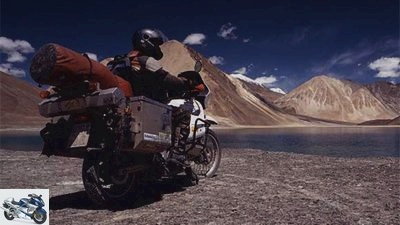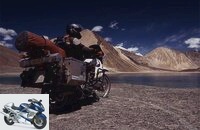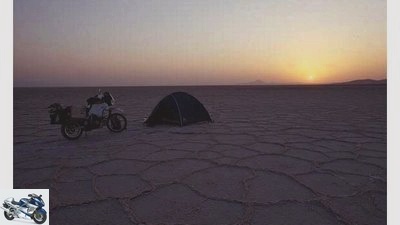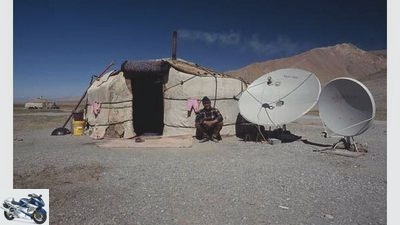Table of contents

Photos: Obert
to travel
South and Central Asia
South and Central Asia
Around the roof of the world
It’s hard to believe, but the idea came spontaneously while we were in Africa. MOTORRAD employee Dietmar Obert completes his two-year trip in India and Central Asia. A search for experience between the ocean and eight-thousanders, megacities and nomad tents, deserts and rice fields.
Dietmar Obert
29/01/2009
Arvind Jain is my confidante: The head of customs at Bombay Airport considers the entry formalities to be mine Transalp within tolerable limits. Two working days for paper and stamp work – Arvind is satisfied, he can’t change anything on the two holidays in between. A crisp white shirt is stretched over his ball belly, behind his old-fashioned horn-rimmed glasses he winks at me and wishes me a pleasant trip to India.
Well, the first 1500 kilometers go by on the train, the motorcycle is simply checked in as luggage. I want to save time, my friend Midori comes to visit me in New Delhi. Then we drive through Rajastan together. With its 50 million inhabitants, this state is considered to be the most densely populated semi-desert on earth. An annual camel market, which we happen to be at, has corresponding dimensions. Even if they only give an idea of their original beauty, we are enchanted by the holy places and old desert cities. The women wear colorful, cropped saris, some of them adorn themselves with very large nose rings or finely crafted chains made of gold or silver that extend from the left nostril to the left ear.
Unfortunately, the insane traffic hinders distant daydreams. Most highways are dominated by agitation, selfishness and chaos. Oncoming trucks in our lane force you to leave the asphalt again and again. For this reason we choose the smallest possible country roads, gondola up to the coast of the state of Gujarat, are hardly faster than the many diesel motorcycles. Their chassis comes from Royal Enfield, a proud owner credibly assures that the fan-cooled built-in engine swallows a maximum of 1.7 liters. I almost get a guilty conscience: After all, the Transalp allows itself five liters.
While Midori is attending a yoga school in Varanassi, I drive to Allahabad, where the rivers Yamuna and Ganges converge. A Kumbh Mela, the largest religious festival in the world, is being held here in January 2007, attended by millions of Hindus. They take part in ritual ablutions on specified bathing days, which are based on certain planetary constellations. Everywhere you see sadhus, the holy men of India. Many of them live in constant penance in their search for enlightenment and therefore have an extremely ascetic lifestyle, some are completely naked.
Buy complete article

South and Central Asia
Around the roof of the world
14 pages) as PDF
€ 2.00
Buy now
So many impressions, so many contrasts: Midori and I appreciate the country and its people more and more, but it dawns on us that we will never really understand India. My girlfriend flies back to Europe from Calcutta.
It is already after 10 a.m. when the sun burns the first hole in a thick blanket of fog. 50 kilometers northeast of Calcutta I cross the border with Bangladesh. On its entry form, the Muslim state wants to know, in addition to my father’s name, whether I am married and how many children I have. I am treated very kindly, a customs officer gives me his mobile number if I should have problems anywhere in the country. In the south, which is criss-crossed by countless waterways, I often have to use completely overloaded, rusty and rattling ferries. Unfortunately, time is of the essence, my visa is only valid for two weeks. So I take a night ferry to the capital Dhaka, from there it continues in a loop to the north.
I reach Nepal over a short distance through India. Another religion, completely different people and – a breathtaking landscape. But the situation in Nepal is tense: In the south-west I count 18 burned-out trucks and buses on the roadside in one day, they are the result of a violent general strike. Again and again there are anti-government rallies. In Kathmandu, however, there are no political but personal surprises in store for me. First, a fillet steak and, for dessert, Black Forest cake. I can hardly remember what it tastes like. And secondly, a shock absorber defect, which I discover when I subject the tranny to a general inspection after more than 30,000 kilometers. The next day I start my return journey to New Delhi, where a new shock absorber is supposed to arrive from Germany. Occasionally I catch a clear view of the snow-capped mountain ranges of the Himalayas, the first peaks on my journey, which tower well over 7000 meters into the sky. I look forward to the months ahead.

Obert
Lonely: The Honda on the salt lake in Dashte Kavir, Iran.
Less than three hours in Pakistan, on the “Grand Truck Road” from Lahore to Islamabad, a driver waves me aside. Imran saw the European license plate and asks in perfect English if I need help. Incidentally, he would like to invite me to dinner at his home. Early the next morning the message of the Koran is announced over the loudspeaker. That’s right, I’m back in the realm of the prophet Mohammed.
We continue through the part of Pakistan that was destroyed by a severe earthquake in 2005. The major aid organizations have set up their tent cities along the road, and the clean-up and reconstruction work is still in full swing. A little further north, in the province of Kohistan, there are no women to be seen on the streets apart from little girls in the villages and towns. An unnatural, man-made world of gender segregation, it seems to me, full of tense, hard faces.
Another piece to the north, in the Karakoram Mountains in the area around Hunza, I encounter Islam in a completely different form, the Ismaili faith. People seem much more open, pray a maximum of twice a day, women take part in public life and only wear a light headscarf. Immediately I feel freer, discover a touching harmony in everything. The rough, at the same time graceful mountain landscape, the bare, high rock walls, the simple stone houses plastered with clay, the faces marked by the harsh climate. I keep bumpy up to the 4700 meter high Khunjerabpass, which forms the border with China. It is very cold, wafts of mist pass by, some hard snowflakes tumble down. The lead-gray cloud cover that is close enough to touch tries to crush me, everything seems dead. Because of the thin air, my machine only runs at a maximum of 4,000 revs. I’m alone because the border won’t open until the beginning of May. But I feel right in the middle of it all, full of euphoria, completely overwhelmed by the sight of the snow-capped giants who greet left and right down to the pass.
A few weeks later I penetrate this mountain world on the Indian side. The Zanskar region is only accessible in the summer months. There is still snow on the passes. Again and again I see young women herding goat or yak herds. They have their heads wrapped in a scarf, leaving only a small slit for the eyes. In this way they protect their skin from the extremely burning sun and from the biting cold in the shade. Seldom before have I seen old people so marked by life at great heights and by the prevailing environmental influences. Deeply carved wrinkles stretch across the parchment-like, dark brown skin of their faces.
In Leh, the provincial capital of Ladakh, I meet Peter and Kai again, who have been traveling the world with a Harley-Davidson for twelve years. We met a year ago. The weather is getting better now, at the end of May, and the sky is clearing. Unfortunately, the motorcycle causes a lot of headache. It smokes and soot, starts extremely poorly, hardly performs any more. I clean the carburetors, screw in new spark plugs – no improvement. A truck driver who speaks no more than 20 words of English takes me and my machine to Manali, 2,500 meters below. There the Honda runs as usual, only the sooty clouds of smoke remain. A petrol station owner explains that in Leh I was probably served a mixture of gasoline, water and kerosene.
Back in Islamabad, Pakistan, I get some visas and spoil the Honda with a new chain set and steering head bearings. On July 3rd at 8:30 am I leave the tourist camp in the city center. Three hours later, the “Lal Masjid” mosque, just a stone’s throw from the campsite and has been occupied by the Koran school director Abdul Rashid Ghazi and a large number of his students since January 2007, is stormed by government troops. Ghazi and his Koran students wanted to force the government to introduce Sharia law, the Islamic criminal law, across Pakistan. I only found out about the fighting when I was in Peshawar. According to official figures, 116 people were killed.
Because for security reasons it is not possible to travel to Central Asia via Afghanistan, the only route that remains is via China. A travel agency with headquarters there enables me to enter the country. Taxkorgan is the name of the first major Chinese city 130 kilometers across the border. I am already expected in the customs building, I am probably the only one entering today. Everything works easier than expected, after a surprisingly short check I roll out into the world of the mountain giants on what is perhaps the best road of my trip to Asia. The 7,546 meter high Muztagata seems within reach.

Obert
Tradition and modernity: nomad yurt on the Pamir Highway in Tajikistan.
In Kashgar I am waiting for my departure to Kyrgyzstan, which also has to be carried out by a travel agency. Away from the old town, Kashgar is full of modern supermarkets that seem unusually clean to me. In the side streets, the brothels disguise themselves as hairdressing salons. Officially, China does not have any prostitution. There are only a few Han Chinese here in Kashgar, they dominate a large part of the shops and are not very popular with the Muslim Uyghur. A two-class society.
In Kyrgyzstan, mare’s milk and horse meat are my staple foods, in the countryside I occasionally pitch my tent next to the nomads’ yurts. Their clothes, their meager household, everything shows how poor these people are. And yet I experience a deeply touching hospitality.
In the south of the country, the huge Pamir mountain ranges form the border with Tajikistan. Over a 4250 meter high and bumpy pass I reach the neighboring country and thus the high plateau of the Pamirs. The vegetation is limited to simple steppe grasses. Shepherds on the mountain slopes drive their goats and yaks through this barren landscape. There is almost no traffic on the Pamir Highway, which runs along the border with China and Afghanistan. The petrol that is drawn from canisters at the petrol stations usually only has 80 octane, but the Transalp runs without any problems.
In northern Uzbekistan I marvel at what is perhaps the greatest human-made environmental disaster of the past century. I’m visiting Moynaq, which used to be a fishing town. When the Aral Sea was back to its original size because its tributaries had not yet been diverted, there was a fish factory here. Today rusty boats lie in the desert sand – what was once the fourth largest inland body of water on earth has retreated more than 100 kilometers from Moynaq.
On the black market of Turkma-nabat in Turkmenistan, I exchange 50 US dollars for a huge bundle of the local currency, the manat. Shortly afterwards I pay 13 dollars to cross a rickety steel bridge, and at the first gas station I am amazed again about the prices in Turkmenistan: For one dollar I would get 60 liters of gasoline. Shortly behind Turkmanabat, the Karakum Desert spreads out, interspersed with small sand dunes and arid brush, cut by a band of asphalt deformed in the sun. Above me a deep blue vault of sky.
In Iran, I am initially drawn to Tehran. On the way, two young Iranian women greet me from a fully occupied car, their dark headscarves barely covering the back of their heads. Their faces are made up and they are very pretty. They shout “Welcome to Iran” to me, waving and in full voices. Her big black eyes shine, I wave back. They push a pomegranate into my dirty left glove. In the next few weeks I will cover more than 5000 kilometers in this huge country, through fascinating desert landscapes and over a salt lake. Sometimes I stay with nomads, whose way of life I admire. Not a day goes by that I am not given some kind of gift. One day they even want to give me money. I refuse, almost shocked by so much generosity.
In a small town near the Persian Gulf, Mehdi, a young man, invites me to eat and stay with his family. At night, however, the police suddenly appear and take me away. One reason for my arrest is quickly found: my papers are not in order. I have to stay at the police station. The next morning my papers are faxed to Shiraz, two hours later I can go. The police chief apologizes very politely for the mistake and invites me to breakfast. My host Mehdi, who translated during the night and in the morning, is terribly embarrassed by the whole thing. Visibly dejected, he apologizes several times. His sisters prayed for me all night.
I feel the cold gathering more and more the further north I go. It has already snowed in northwestern Iran, and eastern Turkey is known for its cold and tough winters. Still, I’m extending my visa. It is only when I finally arrive in Istanbul that it dawns on me why. I feel far removed from the place I call home. What are all my experiences there worth? How long will all the impressions, conversations and friendships stay alive??
Info
Such a dream trip requires preparation. The decisive events, however, cannot be planned. They just happen and mean unforgettable experiences.
Duration of the trip: 13 months; Distance covered: 40,000 kilometers
Travel time
The regions close to the Himalayas such as Ladakh or Zanskar can only be visited in July and August. In all other areas, too, one should take into account the prevailing climatic conditions and adapt the route accordingly. Monsoon rains in India are far from being fun.
Overnight, nutrition
Accommodation options in the form of pensions or hostels are available almost everywhere for relatively little money, but it is advisable to bring a tent with you. In many places you can eat in fast-food restaurants and food stalls on the side of the road, whereby a little caution and attention is required, because German hygiene standards cannot be expected anywhere.
Health, safety
There are no compulsory vaccinations for the countries crossed; hepatitis A / B, typhus, diphtheria, tetanus and polio as well as rabies are recommended. Because malaria areas are crossed, it makes sense to take prophylaxis with you and consult a doctor beforehand. The on-board pharmacy should contain pain relievers, antibiotics, syringes, bandages and disinfectants. Many drugs of the same quality can be purchased very cheaply on the go. In the high regions such as Ladakh or Zanskar, slow acclimatization is essential, otherwise there is a risk of dangerous and very unpleasant altitude sickness. The security situation in many countries is constantly changing, so you should not only inform yourself before you start your journey, but also regularly when you are out and about (www.auswaertiges-amt.de, www.horizonsunlimited.com).
Documents, money
In addition to a passport, national and international driver’s license and vehicle license, a Carnet de Passage is required, which the ADAC issues against bail. Since it is almost impossible to organize all visas from home in the case of a long long-distance journey and some of them are only valid for a limited time after they have been issued, it is better to get the papers on the way either at the borders or in larger cities in the respective neighboring countries . A good address for obtaining visas for Central Asia is David at www.stantours.com; For example, he can send letters of recommendation to the respective embassy and thus enormously speed up the issuing of the visa. The travel agency “New Land International Travel Service” in Kashgar organized an unaccompanied trip to China for 500 euros (Mr. Dong speaks English and can be reached on 0086-998-2228811 or 0086-13579064881. E-Mail: newlandtravel / hotmail .com. It is best to carry several methods of payment with you: travelers checks, cash in euros and dollars and one or better two credit cards. The most common are Visa and Mastercard. The total financial expenditure for the present trip was around 10,000 euros.
Literature, information
Obtaining information about the countries you want to visit before you travel makes sense to take a travel guide for each country with you, but not. Good travel literature and small-scale maps are available in Bombay, Delhi, Calcutta, and Kathmandu.
Long-distance travel by Transalp
Would you have recognized the little 600 Honda? We almost don’t either. Dietmar Obert did a great job with his travel preparations.
With an alp halfway around the globe? The 38-year-old mechanical engineer from Ettenheim near Freiburg saw no handicap for ambitious plans in the originally rather staid touring enduro. And with the small offshoot of the Honda Africa Twin, he conquered the highest Himalayan passes and glowing deserts on a journey that spanned two continents (you can read the Africa Passage in a few weeks). “You don’t drive a rally. The Transalp is an extremely reliable machine and, with its smooth-running two-cylinder, much less strenuous than a single-cylinder. For me that was an important argument in terms of such a long journey. It is also significantly lighter than an Africa Twin, for example. And without any technical frills. Injection, immobilizer or ABS may be okay at home, but when they are out and about they usually increase the problems. A simple motorcycle can always be repaired somehow on the go. ”
Original drive unit The Baden native left the solid drive unit original except for the paper air filter, which he replaced with a washable K&N-Element replaced (“in sand stages I put a ladies sock over it”), as well as a Scottoiler that extended the life of the drive chain. Regular oil changes and adjust valves every 25,000 kilometers – that’s it. Defects: a gel battery that was shaken right at the beginning, a collapsed charge regulator and the failure of the speedometer drive. He donated steel braided lines and replacement discs from Spiegler to the brake, which was no longer completely fresh before the tour, otherwise everything remained in the standard condition.
More range Obert put significantly more hands on the tank. In order to be able to transport more gasoline, he installed the Africa Twin’s 23-liter tank (first model series, fits the Transalp bracket), but increased it to 40 liters by means of sheet metal welded in at the front. During this process, he also relocated the filler neck to the side in order to create a stable support surface for the photo tank bag at the top. “It was a huge effort that was actually not worth it,” he sums up in retrospect. Because the work just continued because the lush tank bag, which had to swallow a mighty Canon EOS 1 including three high-speed zoom lenses, now collided with the handlebars. So Obert put the handlebars higher and without further ado moved the entire steering unit, including the fairing, a few centimeters further forward.
Chassis heavily optimized The tinkerer also put some optimization effort into the chassis. In order to gain ground clearance, with the help of a White Power technician, he extended the strut with a spacer and the telescopic fork by 30 millimeters using self-made extension pieces. He also put up the mudguard and protected the levers with sturdy handlebar protectors. And when the original shock absorber, which was still used at some point, could no longer withstand the loads, he replaced it with a WP part that had been sent to him. “I suspected this was the only major weak point of the motorcycle from the start and had discussed this with White Power.” In order not to lose contact with the ground on the constantly rising motorcycle, the 1.75 meter tall rider had to pad the seat.
Individual luggage solutions Obert’s competence in metalworking can also be seen in all protection and transport components. In addition to a four-millimeter-thick engine guard, he self-made three tool and spare parts containers made of two-millimeter thick aluminum, which he screwed onto the motorcycle at various points. The luggage rack with three frame fixed points and personally measured cases also come from the home workshop. They had already been developed for previous trips and were thus optimally adapted to both the motorcycle and Obert’s transport needs.
Summary: Take another trip like this? “Of course, anytime.” With the Transalp again? “Yes, but 20 kilos less would not be bad.” Was it worth investing so much time and work into such a machine? “Definitely. Motorcycles are my hobby and it was just great fun to set up and optimize the motorcycle myself for the long tour.
Related articles
-
On the way: from north to south through Africa
Obert 22nd pictures Obert 1/22 Sudan: invitation to dinner with new friends in the Nubian desert. Obert 2/22 Local motorcycle ferry across the Rovuma…
-
Pichler to travel South America, part 1 South America, part 1 Call of the Andes Adventure South America: Venezuela, Colombia, Equador, Peru and Bolivia…
-
Trans Africa: The long way from Germany to South Africa
Gerner-Haudum 27 pictures Gerner-Haudum 1/27 A holy book in a Jordanian monastery. Gerner-Haudum 2/27 Botswana: Pachyderms with young animals in the…
-
to travel South Africa South Africa From the monkey valley to hell In the western and eastern Cape provinces of South Africa there are some almost…
-
Photo Pichler to travel South America, part 2 South America, part 2 Dust, storm and gravel After around 14,000 kilometers through five countries in…
-
Motorcycle tour Peru – from south to north
Markus Biebricher 15th pictures Markus Biebricher 1/15 In Peru, one of the most diverse countries on earth, you can commute between the extremes. More…
-
to travel South America South America Patagonia Express Patagonia. Vastness. Huge glaciers. Bizarre mountains. And dusty slopes on which hardly anyone is…
-
to travel South America ?? Antarctic South America ?? Antarctic 42 degrees of latitude On two enduros through the Andes ?? from the Chilean Atacama…
-
Pichler 25th pictures Pichler 1/25 The Austrian adventurer Joe Pichler on his 27,000 km journey through Asia. Pichler 2/25 The long way to the east….
-
On the move: Spain from north to south
Deleker 15th pictures Deleker 1/15 With the motorcycle across Spain, a trip with many highlights. Deleker 2/15 Ready for a movie: Spain’s castles are…